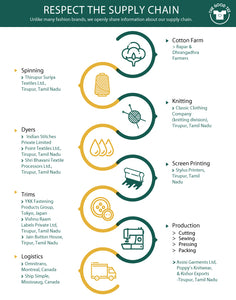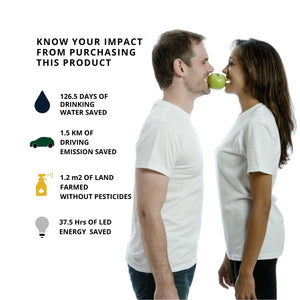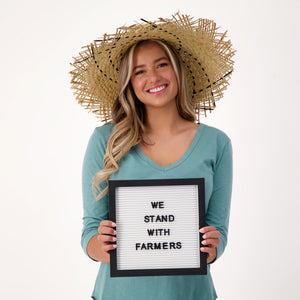Why Ethical Fashion Is Actually The Better Deal- How to Calculate Cost Per Wear

Does the price of clothing hold you back from making that purchase? One of the biggest drawbacks people associate with sustainable or ethical clothing is the price point. Usually, when compared to fast fashion apparel, sustainable clothing is priced higher. This is due to the fact that clothes are made ethically and take into account responsibly sourced materials, good wages for workers, and other morally correct aspects that lead to a higher cost of production.
When you think of sustainable clothing, you would also need to consider all of the costs that go into it. A significant part of the cost is taken up by fabric and labor, especially when sourced overseas. So if a company responsibly made, such as organic cotton fabric, that would add to the cost. Similarly, paying fair wages to the workers who make the clothing will also add to the cost of the final product.
Big Brands (Fast Fashion) Versus Small Brands (Slow Fashion)
Products made by fast fashion companies end up in the landfills much faster, contributing to a negative environmental impact. Fast fashion is meant to create trends that die, products that fall apart- pushing you to keep buying.
Slow fashion is the movement of designing, creating, and buying garments for quality and longevity. It encourages slower production schedules, fair wages, lower carbon footprints, and (ideally) zero waste. Choosing to support smaller companies who pride themselves on small, responsibly made thoughtful batches means also supporting a business that typically works with smaller manufacturers with higher standards of quality and working conditions for people. The goal in mind with sustainable products is to try to keep the product away from landfills as long as possible.
We, at The Good Tee, pride ourselves in being transparent about what we do and how we do it. We want to educate and inspire our already thoughtful customers into becoming more conscious consumers by buying fewer, higher-quality pieces that stand the test of time.
HOW IT CAN HELP YOU SAVE MONEY
But really, does this mean fast fashion is always cheaper in the long term? We don’t think so. When clothes are produced in the fast fast fashion way, chances are that they will be worn very few times, either because the trend goes out of style or the quality of the clothing goes down very fast. This means you will end up buying more clothes in a certain period of time, which quickly adds up! Fast
What is Cost Per Wear?
A better way to understand how much you are actually spending on your clothing is a concept called ‘cost per wear’ or CPW. Cost per wear is simply a calculation that enables you to see the lifetime value of a purchase and how much it costs you every time you wear it.

How to Calculate Cost Per Wear
If we look at fast fashion clothing, the initial cost may be cheaper - for example, a shirt may cost just $30. But you may not get more than 5 wears out of it before the material starts fraying and you just can’t wear it anymore. So, in this case, the cost per wear will be $30 divided by 5 wears (the fast fashion average), which gives you $6 per wear. Assuming the garment will fall apart or no longer be of use after 5 wears, which is a typical average.
Compare this to our popular batwing tee made ethically and sustainably. You may end up paying more initially, let's say $57. But you end up wearing it at least 50 times (if not more, estimating you wear the item 4 times a month in year, however over life of a good quality product it last 5+ years (250 times)), and there itself you can see that your cost per wear will be $57 divided by 50, which is $1.14 (5 years it is $0.22). So, this is going to cost you less to use than a fast fashion shirt. The same applies to any apparel made responsibly and designed and made with quality in mind.
This means less waste and fewer quickly cycled clothing pieces being sent to landfills. Wearing clothing 50 times (one single year) instead of 5 times (the fast fashion average) reduces carbon emissions by more than 400% per item per year.

What Should I Consider When Considering Cost Per Wear?
You have to take your own budget and circumstances into consideration when it comes to CPW. We understand investment pieces might not be possible. We’re advocating for a conscious look at your clothes, if it works for you.
- Will you still want to wear it in 5-10 years?
- Can you see yourself wearing this in years to come?
- Have I looked at my closet before purchasing, Is it needed?
- Is this item something you will wear alot or sit at the back of your closet?
- Can this item be styled in numerous ways?
- Is it comfortable?
- Is it the clothing made from sustainable fabrics?
- Will this product last? Is the fabric top quality? Are the items sewn with strong seams?
HOW THE GOOD TEE IS DESIGNED TO CONSIDER COST PER WEAR
The Good Tee was built on the foundation of creating high-quality fashion essentials that you will love to wear and last for years to come. We make sure that our workers are treated and compensated properly. Our workmanship and quality control standards are very high to ensure that products are durable. We also make sure to source sustainable and responsibly made, which leads to a higher quality of materials.
If you take one of our popular t-shirts, the Unisex Baseball Tee, the price of $42 may seem higher than other fast fashion alternatives. But if you look at it from the CPW perspective, you’ll quickly realize that you’re going to get 10 times the number of wears out of our tee than you would from a fast-fashion alternative. If you wore our baseball tee 50 times over a year (we estimate our product will last you a minimum of 5 years), over the life it would cost you $0.17 cents) What! Yes I repeat $0.17! As compared to an outfit from a fast fashion brand that cost $20 and can be worn just 4 times amounting to a cost per wear of $5.

The image below shows how we address each stage in the life cycle of a garment. We think about the entire life of the product and at each stage address how we can improve to produce a responsibly made product. At every stage, we think about sustainability and being responsible both to the environment and people.

How we can do our part
When we, both businesses and consumers, work together and focus on Cost per Wear (CPW) when designing, creating, and buying responsibly made clothing, we all get to reap the rewards.
Giving brands customer feedback and product reviews helps us to create better products. Demand better. We bring awareness to product quality and environmental impacts, and influence companies to raise their standards- better quality products, sustainably made and ethically sourced. All of these cumulate to bringing you higher-quality, longer-lasting products that you’ll be able to love for a long time and feel good about buying.
Join us on our journey — to start building a more curated wardrobe with thoughtful, timeless classics that act as the chameleon pieces of your style. Spending consciously and aiming for a positive impact never goes out of style.







Leave a comment